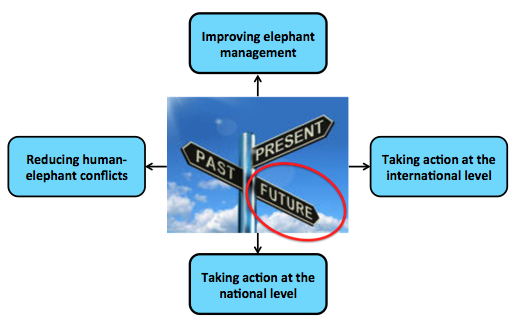In this section, we will be exploring four areas that need to be done in order to manage and conserve the Asian elephant populations and their habitats:
Reducing Human-Elephant Conflicts
Adopt sound land-use planning strategies
First of all, encourage the use of sound land-use strategies that would keep elephants from straying into human settlements. Strategies may include the following:
- Develop mechanisms to predict where human-elephant conflicts are likely to occur.
- Enlist the support of governments and local communities to plan land usage so as to minimise the likelihood of human-elephant conflicts from taking place.
- In areas where people and elephants are bound to meet, people must derive tangible benefits from the presence of the elephants.
- Master plans should take elephant reserves in various countries into consideration so that future development projects do not fragment elephant habitat while planning for land uses.
- The environmental impact of development projects in elephant range should be evaluated well in advance so that the interests of elephants and people are provided for.
Create managed elephant ranges
The concept of “managed elephant ranges” offers a compromise whereby both elephants and people could share land resources. Land-use practices that are beneficial to elephants may consist of slow rotation timber harvesting, extraction of forest produce, or a low level of shifting cultivation, could be practiced in these multi-use landscapes.
Benefit local communities
Communities living in proximity to elephants should benefit from their presence. Long-term residents around protected areas can be hired as trackers, rangers, elephant drivers, and trainers at fair wage scales comparable to employees hired from outside the region.
Revenues from tourism could then be shared with communities through a direct percentage of return, or through employment in the tourist industry. In addition, ecotourism or other small-scale businesses could also provide some revenues, albeit probably not enough to meet all the communities’ needs.
Taking Action at National Level
Prepare or revise national action plans for elephant conservation
Each country can prepare its own National Action Plan to identify its priorities for elephant conservation.
Hold national and transnational corporations accountable
Governments should take steps to ensure that national and transnational companies exploiting natural resources in elephant range comply with national legislation regarding biodiversity protection, and are accountable for partaking in the use of sound forest-use practices.
Taking Action at the International Level
Demonstrate political will and commitment
The socio-economic and political pressures that confront areas set aside for elephants have become a critical issue in Southeast Asia. A meeting, at senior (for e.g. ministerial) level, among the countries where Asian elephants occur can help obtain a firm commitment to conserve and manage the species across its range. Moreover, there is an increasing need to step up and adopt the use of revised national and even sub-regional conservation strategies to address issues such as unsustainable logging, the expansion of palm-oil plantations, and other development schemes.
Educate consumers and producers about eco-labelled forest products
As long as demand for timber and for non-timber forest products remains high, there will be little incentive for companies to modify their unsustainable practices. Hence, consumers need to be encouraged to buy products from forests that are managed sustainably. For example, buyers can purchase goods made from timber that is certified in accordance with the rules of the Forest Stewardship Council (FSC). To further support this initiative, corporations should be encouraged to participate in the FSC and produce forest products that carry the eco-label of the FSC.
Monitor and stop the ivory trade in Southeast Asia
Populations of wild elephants in Southeast Asia are suffering declines due to the illegal trade in ivory. Thus, there is an urgent need to step up the monitoring and investigation of the illegal ivory trade. On top of that, all countries with elephants should enforce the Convention on International Trade of Endangered Species in Wild Fauna and Flora (CITES) regulations. In addition, existing national legislation should also be reviewed, and strengthened where necessary.
Improving Elephant Management
Undertake more research
Scientific research is needed on:
- Census techniques (methods of counting elephants)
- Monitoring of sex and age ratios in the wild
- Effectiveness of protected areas and the corridors linking them
- Habitat evaluation
- The effects of translocation (translocation in wildlife conservation refers to the capture, transport and release or introduction of species, habitats or other ecological material [such as soil] from one location to another)
Discourage capture of wild elephants for domestication
Domesticated elephant populations should be maintained, as far as possible, by captive breeding rather than by taking elephants from the wild. Where capture of wild elephants is necessary, methods that minimise the risks subjected to the elephants should be used. In addition, data on the biology of captive elephants should also be maintained and analysed in order to support conservation of wild elephants.
Read More: Timber Trade and Illegal Logging, The Palm Oil Problem, Human-Elephant Conflict, Illegal Hunting and Trade, Capture of Wild Elephants, Conservation Efforts, Challenges

